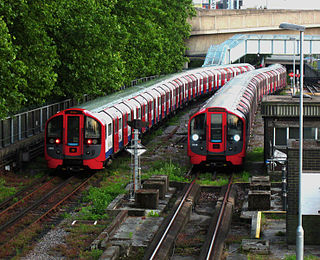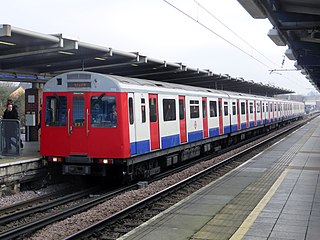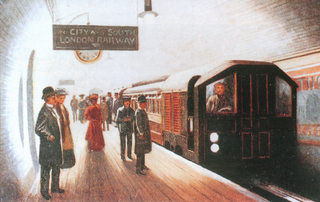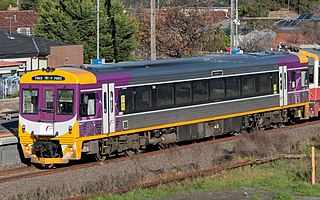
A conductor or guard is a train crew member responsible for operational and safety duties that do not involve actual operation of the train/locomotive. The conductor title is most common in North American railway operations, but the role is common worldwide under various job titles. In Commonwealth English, a conductor is also known as guard or train manager.

The T sets, also referred to as the Tangara trains, are a class of electric multiple units (EMU) that operate on the Sydney Trains network. Built by A Goninan & Co, the sets entered service between 1988 and 1995, initially under the State Rail Authority and later on CityRail. The T sets were built as "third-generation" trains for Sydney's rail fleet, coinciding with the final withdrawals of the "Red Rattler" sets from service in the late 1980s and early 1990s. The Tangaras were initially built as two classes; the long-distance intercity G sets and the suburban T sets, before being merged after successive refurbishments.

On trains, the expression emergency brake has several meanings:

London Underground rolling stock includes the electric multiple-unit trains used on the London Underground. These come in two sizes, smaller deep-level tube trains and larger sub-surface trains of a similar size to those on British main lines, both running on standard gauge tracks. New trains are designed for the maximum number of standing passengers and for speed of access to the cars.

The 4D was a prototype double deck electric multiple unit built for the Public Transport Corporation in Victoria, Australia, for operation on the Melbourne railway system. It remains the only double deck train to have ever operated in Melbourne. The train's name stood for "Double Deck Development and Demonstration."

The British Rail Class 166 Networker Turbo is a fleet of diesel-hydraulic multiple unit passenger trains, built by ABB Transportation at their Holgate Road Works in York between 1992 and 1993. They were specified by and built for British Rail, the state-owned railway operator in Great Britain at the time. The trains were designed as a faster, air-conditioned variant of the Class 165 Turbo, intended for longer-distance services, and, like the 165s, belong to the Networker family of trains. They are known as Networker Turbos to distinguish them from the electrically propelled members of that family. Today the 166s, alongside the 165s, are normally referred to as Thames Turbos, the Networker Turbo Express or just simply Turbos.
The Lancashire and Yorkshire Railway (LYR) built suburban electric stock for lines in Liverpool and Manchester. The line between Liverpool to Southport began using electric multiple units (EMUs) on 22 March 1904, using a third rail 625 V DC. Additional trains were later built for this route, and in 1913 incompatible stock for the route to Ormskirk. Lightweight units were built to run on the Liverpool Overhead Railway.

The British Rail Class 222 Meridian is a group of 5- or 7- car diesel-electric multiple-unit high-speed passenger train capable of 125 mph (200 km/h). Twenty-seven sets were built by Bombardier Transportation in Bruges, Belgium.

The British Rail Class 444 Desiro is an electric multiple-unit passenger train built by Siemens Transportation Systems in Austria between 2002 and 2004. The Class 444 currently operate on express passenger services for South Western Railway.

The Harris trains were the first steel-bodied electric multiple unit (EMU) trains to operate on the suburban railway network of Melbourne, Victoria, Australia. They were introduced in 1956, by the Victorian Railways, and last operated in 1988, although a number of the carriages were converted for other uses and are still operating. They were named after Norman Charles Harris, Chairman of Commissioners of the Victorian Railways, between 1940 and 1950.

The London Underground D78 Stock, commonly referred to as D Stock, was a type of sub-surface rolling stock which operated on the District line of the London Underground, except on the Wimbledon to Edgware Road service. The first units were withdrawn in January 2015 with the last withdrawn on 21 April 2017.

The New South Wales H sets, commonly referred to as the OSCAR trains, are a class of electric multiple units (EMU) currently operated by Sydney Trains on its intercity routes and some Sydney suburban routes. Built by UGL Rail in Broadmeadow, the H sets first entered service under the CityRail brand in December 2006, with the last in December 2012. Their introduction allowed for the retirement of some second-class V set carriages. As long-distance trains, the H sets share a similar overall layout and design to the previous Intercity Tangara G sets. Currently operating as 55 four-carriage sets, the H sets now operate between Sydney, Central Coast and Newcastle and between Sydney and the South Coast.

The Central London Railway Stock were electric multiple units composed of trailers that had been converted from carriages designed to be hauled by electric locomotives with new motor cars. The Central London Railway opened in 1900 with electric locomotives hauling wooden carriages, but the heavy locomotives caused vibrations that could be felt in the buildings above the route. It was found that conversion to electric multiple units solved the problem, so new motor cars were bought and replaced all the locomotives by June 1903. Trains normally ran with six-cars, four trailers and two motor-cars. Some trailers were equipped with control equipment to allow trains to be formed with three cars.

The Wairarapa Connection is a New Zealand interurban commuter rail service along the Wairarapa Line between Masterton, the largest town in the Wairarapa, and Wellington. It is operated by Wellington suburban operator Transdev under contract from the Greater Wellington Regional Council. It is a diesel-hauled carriage service, introduced by the New Zealand Railways Department in 1964 after passenger demand between Masterton to Wellington exceeded the capacity of the diesel railcars then used.

The Vline Sprinters are diesel railcars which are operated by V/Line on its Seymour line service with some also leased to Metro Trains Melbourne for its Stony Point line commuter service. They were built between 1993 and 1995 by A Goninan & Co in Broadmeadow, New South Wales.

Metropolitan Railway electric multiple units were used on London's Metropolitan Railway after the lines were electrified in the early 20th century.

The British Rail Class 331 Civity is a class of electric multiple unit built by CAF, owned by Eversholt Rail Group, and currently operated by Northern Trains. A total of 43 units have been built – 31 three-car units and 12 four-car units. Construction of the trains started in July 2017 and they were phased into service from 1 July 2019.

The British Rail Class 195 is a class of diesel multiple-unit passenger train from the Civity family manufactured by CAF, owned by Eversholt Rail Group and currently operated by Northern Trains. A total of 58 units have been built; 25 two-car units and 33 three-car units. The class is almost identical to the Class 331 also produced by CAF, which is the electric version of the Class 195, differing only in traction type and vehicle formation.
This article outlines the history and types of passenger rolling stock and guards vans on the narrow-gauge lines of the Victorian Railways in Australia. The types were constructed in parallel with very similar designs.

The British Rail Class 555 Metro is a class of electric multiple units, commissioned and built for the Tyne and Wear Passenger Transport Executive (Nexus) by the Swiss company Stadler Rail, at a total cost of £362 million, for use on the Tyne and Wear Metro. For operation on Network Rail controlled tracks between Pelaw Junction and Sunderland, they are designated on TOPS as the Class 555.


















